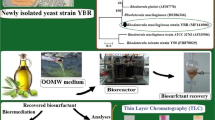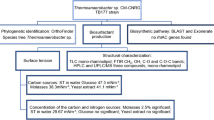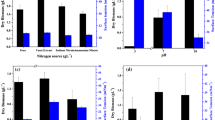Abstract
Biosurfactants (BSs) are known for their remarkable properties, however, their commercial applications are hampered partly by the high production cost. To overcome this issue, a biosurfactant producing strain, Rhodotorula sp.CC01 was isolated using landfill leachate as nitrogen source, while olive oil was determined as the best sole carbon source. The BS produced by Rhodotorula sp.CC01 had oil displacement diameter of 19.90 ± 0.10 cm and could reduce the surface tension of water to 34.77 ± 0.63 mN/m. It was characterized as glycolipids by thin layer chromatography, FTIR spectra, and GC–MS analysis, with the critical micelle concentration of 70 mg/L. Meanwhile, the BS showed stability over a wide range of pH (2–12), salinity (0–100 g/L), and temperature (20–100 °C). During the cultivation process, BS was produced with a maximum rate of 163.33 mg L−1 h−1 and a maximum yield of 1360 mg/L at 50 h. In addition, the removal efficiency of NH4+–N reached 84.2% after 75 h cultivation with a maximum NH4+–N removal rate of 3.92 mg L−1 h−1. Moreover, Rhodotorula sp.CC01 has proven to be of great potential in remediating petroleum hydrocarbons, as revealed by chromogenic assays. Furthermore, genes related to nitrogen metabolism and glycolipid metabolism were found in this strain CC01 after annotating the genome data with KEGG database, such as narB, glycoprotein glucosyltransferase, acetyl-CoA C-acetyltransferase, LRA1, LRA3, and LRA4. The findings of this study prove a cost-effective strategy for the production of BS by yeast through the utilization of landfill leachate.
Graphical abstract



source for BS production by strain CC01. b Kinetics of growth and ST of strain CC01 during 243 h of incubation. The ST decreased to 28.20 ± 0.51 mN/m at 15 h and remained stable and biomass reached a maximum at 147 h. The error bars represent the standard deviations (n = 3)





Similar content being viewed by others
References
Adnan M, Alshammari E, Ashraf SA, Patel K, Lad K, Patel M (2018) Physiological and molecular characterization of biosurfactant producing endophytic fungi Xylaria regalis from the cones of Thuja plicata as a potent plant growth promoter with its potential application. Biomed Res Int 2018:7362148
Adnan M, Siddiqui AJ, Hamadou WS, Ashraf SA, Hassan MI, Snoussi M, Badraoui R, Jamal A, Bardakci F, Awadelkareem AM, Sachidanandan M, Patel M (2021) Functional and structural characterization of pediococcus pentosaceus-derived biosurfactant and its biomedical potential against bacterial adhesion, quorum sensing, and biofilm formation. Antibiotics (Basel) 10(11):1371
Aparna A, Srinikethan G, Smitha H (2012) Production and characterization of biosurfactant produced by a novel Pseudomonas sp. 2B. Colloids Surf B Biointerfaces 95:23–29
Ashitha A, Radhakrishnan EK, Mathew J (2020) Characterization of biosurfactant produced by the endophyte Burkholderia sp. WYAT7 and evaluation of its antibacterial and antibiofilm potentials. J Biotechnol 313:1–10
Burgos-Diaz C, Pons R, Espuny MJ, Aranda FJ, Teruel JA, Manresa A, Ortiz A, Marques AM (2011) Isolation and partial characterization of a biosurfactant mixture produced by Sphingobacterium sp. isolated from soil. J Colloid Interface Sci 361(1):195–204
Cameron DR, Cooper DG, Neufeld RJJA, Microbiology E (1988) The mannoprotein of Saccharomyces cerevisiae is an effective bioemulsifier. Appl Environ Microbiol 54(6):1420
Carolin CF, Kumar PS, Ngueagni PT (2021) A review on new aspects of lipopeptide biosurfactant: types, production, properties and its application in the bioremediation process. J Hazard Mater 407:124827
Chandankere R, Yao J, Cai M, Masakorala K, Jain AK, Choi MMF (2014) Properties and characterization of biosurfactant in crude oil biodegradation by bacterium Bacillus methylotrophicus USTBa. Fuel 122:140–148
Civiero E, Pintus M, Ruggeri C, Tamburini E, Sollai F, Sanjust E, Zucca P (2018) Physiological and phylogenetic characterization of Rhodotorula diobovata DSBCA06, a Nitrophilous yeast. Biology (Basel), 7(3).
Datta P, Tiwari P, Pandey LM (2018) Isolation and characterization of biosurfactant producing and oil degrading Bacillus subtilis MG495086 from formation water of Assam oil reservoir and its suitability for enhanced oil recovery. Bioresour Technol 270:439–448
Derguine L, Kebbouche S, Djenane D (2021) Biosurfactant production from newly isolated Rhodotorula sp. YBR and its great potential in enhanced removal of hydrocarbons from contaminated soils. World J Microbiol Biotechnol 37(1):18
Dobler L, Ferraz HC, Araujo de Castilho LV, Sangenito LS, Pasqualino IP, Souza Dos Santos AL, Neves BC, Oliveira RR, Guimaraes Freire DM, Almeida RV (2020) Environmentally friendly rhamnolipid production for petroleum remediation. Chemosphere 252:126349
Dvoranová D, Barbieriková Z, Dorotíková S, Malček M, Brincko A, Rišpanová L, Bučinský L, Staško A, Brezová V, Rapta P (2015) Redox processes of 2,6-dichlorophenolindophenolate in different solvents. A combined electrochemical, spectroelectrochemical, photochemical, and theoretical study. J Solid State Electrochem 19(9):2633–2642
Eldin AM, Z.K., Nermeen Hossam. (2019) Isolation and genetic identification of yeast producing biosurfactants, evaluated by different screening methods. Microchem J 146:309–314
Eldin AM, Kamel Z, Hossam N (2019) Isolation and genetic identification of yeast producing biosurfactants, evaluated by different screening methods. Microchem J 146:309–314
Femina Carolin C, Kumar PS, Joshiba GJ, Madhesh P, Ramamurthy R (2021) Sustainable strategy for the enhancement of hazardous aromatic amine degradation using lipopeptide biosurfactant isolated from Brevibacterium casei. J Hazard Mater 408:124943
Fonseca RR, Silva AJR, De França FP, Cardoso VL, Sérvulo EFC (2007) Optimizing carbon/nitrogen ratio for biosurfactant production by a Bacillus subtilis strain. Appl Biochem Biotechnol 137(1):471–486
He T, Li Z, Sun Q, Xu Y, Ye Q (2016) Heterotrophic nitrification and aerobic denitrification by Pseudomonas tolaasii Y-11 without nitrite accumulation during nitrogen conversion. Bioresour Technol 200:493–499
He S, Ni Y, Lu L, Chai Q, Yu T, Shen Z, Yang C (2020) Simultaneous degradation of n-hexane and production of biosurfactants by Pseudomonas sp. strain NEE2 isolated from oil-contaminated soils. Chemosphere 242:125237
Huang X, Zhou H, Ni Q, Dai C, Chen C, Li Y, Zhang C (2020) Biosurfactant-facilitated biodegradation of hydrophobic organic compounds in hydraulic fracturing flowback wastewater: a dose–effect analysis. Environ Technol Innov 19:100889
Huang Y, Zhou H, Zheng G, Li Y, Xie Q, You S, Zhang C (2020b) Isolation and characterization of biosurfactant-producing Serratia marcescens ZCF25 from oil sludge and application to bioremediation. Environ Sci Pollut Res Int 27(22):27762–27772
Jezierska S, Claus S, Van Bogaert I (2018) Yeast glycolipid biosurfactants. FEBS Lett 592(8):1312–1329
Junhui Zhang HL, Gao H, Shibin Hu, Xue Q (2018) Prevention and mitigation of paraffin deposition by biosurfactant-producing and paraffin-degrading Bacillus amyloliquefaciens strain 6–2c. Chem Eng J 335:510–519
Koc-Jurczyk J, Jurczyk L (2017) Biological treatment of landfill leachate at elevated temperature in the presence of polyurethane foam of various porosity. Clean-Soil Air Water 45(3):1500264
Liu H, Wang H, Chen X, Liu N, Bao S (2014) Biosurfactant-producing strains in enhancing solubilization and biodegradation of petroleum hydrocarbons in groundwater. Environ Monit Assess 186(7):4581–4589
Lu LL, Wang BJ, Zhang Y, Xia LJ, An D, Li HJ (2019) Identification and nitrogen removal characteristics of Thauera sp. FDN-01 and application in sequencing batch biofilm reactor. Sci Total Environ 690:61–69
Luna JM, Rufino RD, Sarubbo LA, Campos-Takaki GM (2013) Characterisation, surface properties and biological activity of a biosurfactant produced from industrial waste by Candida sphaerica UCP0995 for application in the petroleum industry. Colloids Surf B Biointerfaces 102:202–209
Marcelino PRF, Peres GFD, Terán-Hilares R, Pagnocca FC, Rosa CA, Lacerda TM, dos Santos JC, da Silva SS (2019) Biosurfactants production by yeasts using sugarcane bagasse hemicellulosic hydrolysate as new sustainable alternative for lignocellulosic biorefineries. Ind Crops Prod 129:212–223
Markande AR, Patel D, Varjani S (2021) A review on biosurfactants: properties, applications and current developments. Bioresour Technol 330:124963
Nazareth TC, Zanutto CP, Maass D, de Souza AAU, de Guelli Ulson de Souza SMDA (2021) Bioconversion of low-cost brewery waste to biosurfactant: an improvement of surfactin production by culture medium optimization. Biochem Eng J 172:108058
Nogueira Felix AK, Martins JJL, Lima Almeida JG, Giro MEA, Cavalcante KF, Maciel Melo VM, Loiola Pessoa OD, Ponte Rocha MV, Rocha Barros Goncalves L, Saraiva de Santiago Aguiar R (2019) Purification and characterization of a biosurfactant produced by Bacillus subtilis in cashew apple juice and its application in the remediation of oil-contaminated soil. Colloids Surf B Biointerfaces 175:256–263
Ohadi M, Dehghannoudeh G, Shakibaie M, Banat IM, Pournamdari M, Forootanfar H (2017) Isolation, characterization, and optimization of biosurfactant production by an oil-degrading Acinetobacter junii B6 isolated from an Iranian oil excavation site. Biocatal Agric Biotechnol 12:1–9
Ouyang L, Wang K, Liu X, Wong MH, Hu Z, Chen H, Yang X, Li S (2020) A study on the nitrogen removal efficacy of bacterium Acinetobacter tandoii MZ-5 from a contaminated river of Shenzhen, Guangdong Province, China. Bioresour Technol 315:123888
Pirsaheb M, Azizi E, Almasi A, Soltanian M, Khosravi T, Ghayebzadeh M, Sharafi K (2015) Evaluating the efficiency of electrochemical process in removing COD and NH4–N from landfill leachate. Desalin Water Treat 57(15):6644–6651
Priya A, Mandal AK, Ball AS, Manefield M, Lal B, Sarma PM (2015) Mass culture strategy for bacterial yeast co-culture for degradation of petroleum hydrocarbons in marine environment. Mar Pollut Bull 100(1):191–199
Ren Y, Ferraz F, Kang AJ, Yuan Q (2017) Treatment of old landfill leachate with high ammonium content using aerobic granular sludge. J Biol Eng 11:42
Rosas-Galvan NS, Martinez-Morales F, Marquina-Bahena S, Tinoco-Valencia R, Serrano-Carreon L, Bertrand B, Leon-Rodriguez R, Guzman-Aparicio J, Alvarez-Berber L, Trejo-Hernandez MR (2018) Improved production, purification, and characterization of biosurfactants produced by Serratia marcescens SM3 and its isogenic SMRG-5 strain. Biotechnol Appl Biochem 65(5):690–700
Rufino RD, Luna JM, Sarubbo LA, Rodrigues LR, Teixeira JA, Campos-Takaki GM (2011) Antimicrobial and anti-adhesive potential of a biosurfactant Rufisan produced by Candida lipolytica UCP 0988. Colloids Surf B Biointerfaces 84(1):1–5
Santos APP, Silva MDS, Costa EVL, Rufino RD, Santos VA, Ramos CS, Sarubbo LA, Porto ALF (2017) Production and characterization of a biosurfactant produced by Streptomyces sp. DPUA 1559 isolated from lichens of the Amazon region. Braz J Med Biol Res 51(2):e6657
Sen S, Borah SN, Bora A, Deka S (2017) Production, characterization, and antifungal activity of a biosurfactant produced by Rhodotorula babjevae YS3. Microb Cell Fact 16(1):95
Senthil Balan S, Ganesh Kumar C, Jayalakshmi S (2019) Physicochemical, structural and biological evaluation of Cybersan (trigalactomargarate), a new glycolipid biosurfactant produced by a marine yeast, Cyberlindnera saturnus strain SBPN-27. Process Biochem 80:171–180
Sharma S, Pandey LM (2020) Production of biosurfactant by Bacillus subtilis RSL-2 isolated from sludge and biosurfactant mediated degradation of oil. Bioresour Technol 307:123261
Sood N, Lal B (2009) Isolation of a novel yeast strain Candida digboiensis TERI ASN6 capable of degrading petroleum hydrocarbons in acidic conditions. J Environ Manag 90(5):1728–1736
Sun S, Wang Y, Zang T, Wei J, Wu H, Wei C, Qiu G, Li F (2019) A biosurfactant-producing Pseudomonas aeruginosa S5 isolated from coking wastewater and its application for bioremediation of polycyclic aromatic hydrocarbons. Bioresour Technol 281:421–428
Teixeira KS, Gudina EJ, Schwan RF, Rodrigues LR, Dias DR, Teixeira JA (2018) Improvement of biosurfactant production by Wickerhamomyces anomalus CCMA 0358 and its potential application in bioremediation. J Hazard Mater 346:152–158
Wang F, Smith DW, El-Din MG (2003) Application of advanced oxidation methods for landfill leachate treatment—a review. J Environ Eng Sci 2(6):413–427
Wang R, Xu Q, Chen C, Li X, Zhang C, Zhang D (2021) Microbial nitrogen removal in synthetic aquaculture wastewater by fixed-bed baffled reactors packed with different biofilm carrier materials. Bioresour Technol 331:125045
Wei Z, Wang JJ, Meng Y, Li J, Gaston LA, Fultz LM, DeLaune RD (2020) Potential use of biochar and rhamnolipid biosurfactant for remediation of crude oil-contaminated coastal wetland soil: ecotoxicity assessment. Chemosphere 253:126617
Wu L, Zhang LY, Xu YY, Liang CZ, Kong H, Shi X, Peng YZ (2016) Advanced nitrogen removal using bio-refractory organics as carbon source for biological treatment of landfill leachate. Sep Purif Technol 170:306–313
Wu C, Chen W, Gu Z, Li Q (2020) A review of the characteristics of Fenton and ozonation systems in landfill leachate treatment. Sci Total Environ 762:143131
Xiao B, Yang D-Y, Shi R-J, Zhang Y, Zhang Y, Hao J-S, Li G-Q, Zhao J-Y (2013) Screening of an efficient biosurfactant-producing bacterial strain and the structure and property of its surface-active metabolic product. Shengtaixue Zazhi 32(3):779–786
Xu M, Fu X, Gao Y, Duan L, Xu C, Sun W, Li Y, Meng X, Xiao X (2020) Characterization of a biosurfactant-producing bacteria isolated from Marine environment: surface activity, chemical characterization and biodegradation. J Environ Chem Eng 8(5):104277
Yang Z, Hollebone BP, Shah K, Yang C, Brown CE, Dodard S, Sarrazin M, Sunahara G (2020) Biodegradation potential assessment by using autochthonous microorganisms from the sediments from Lac Megantic (Quebec, Canada) contaminated with light residual oil. Chemosphere 239:124796
Yoshiwara K, Watanabe S, Watanabe Y (2021) Crystal structure of l-rhamnose 1-dehydrogenase involved in the nonphosphorylative pathway of l-rhamnose metabolism in bacteria. FEBS Lett 595(5):637–646
Yu D, Yang J, Teng F, Feng L, Fang X, Ren H (2014) Bioaugmentation treatment of mature landfill leachate by new isolated ammonia nitrogen and humic acid resistant microorganism. J Microbiol Biotechnol 24(7):987–997
Yuan CL, Lu CH, Ma YG, Wang YZ, Xie YH, Zhang K, Wang YQ, Lv LT, Feng XL, Zhu T (2019) A novel method to treat old landfill leachate combining multi-stage biological contact oxidation (MBCO) and single-stage autotrophic nitrogen removal using anammox and partial nitrification (SNAP). Chem Eng J 359:1635–1643
Zeng Z, Liu Y, Zhong H, Xiao R, Zeng G, Liu Z, Cheng M, Lai C, Zhang C, Liu G, Qin L (2018) Mechanisms for rhamnolipids-mediated biodegradation of hydrophobic organic compounds. Sci Total Environ 634:1–11
Zeng J, Liao S, Qiu M, Chen M, Ye J, Zeng J, Wang A (2020) Effects of carbon sources on the removal of ammonium, nitrite and nitrate nitrogen by the red yeast Sporidiobolus pararoseus Y1. Bioresour Technol 312:123593
Zhang QL, Liu Y, Ai GM, Miao LL, Zheng HY, Liu ZP (2012a) The characteristics of a novel heterotrophic nitrification-aerobic denitrification bacterium, Bacillus methylotrophicus strain L7. Bioresour Technol 108:35–44
Zhang F, Li X, Wang Z, Jiang H, Ren S, Peng Y (2020) Simultaneous Ammonium oxidation denitrifying (SAD) in an innovative three-stage process for energy-efficient mature landfill leachate treatment with external sludge reduction. Water Res 169:115156
Zhang X, Zhang Y, Dai C, Xu D (2012b) Comparison of three methods of measuring rhamnolipids using sugar development process. 19(1):31–41
Zhou H, Chen J, Yang Z, Qin B, Li Y, Kong X (2015) Biosurfactant production and characterization of Bacillus sp. ZG0427 isolated from oil-contaminated soil. Ann Microbiol 65(4):2255–2264
Zhou H, Huang X, Liang Y, Li Y, Xie Q, Zhang C, You S (2020) Enhanced bioremediation of hydraulic fracturing flowback and produced water using an indigenous biosurfactant-producing bacteria Acinetobacter sp. Y2. Chem Eng J 397:125348
Zhou H, Jiang L, Li K, Chen C, Lin X, Zhang C, Xie Q (2021) Enhanced bioremediation of diesel oil-contaminated seawater by a biochar-immobilized biosurfactant-producing bacteria Vibrio sp. LQ2 isolated from cold seep sediment. Sci Total Environ 793:148529
Acknowledgements
This study was financially supported by Zhoushan Science and Technology Department Project (Grant No. 2019C81056), the National Natural Science Foundation of China (Grant Nos. 51978189; 52070050), and by the Research Funds of the Guangxi Key Laboratory of Theory and technology for Environmental Pollution Control (Grant No. 2001K004).
Author information
Authors and Affiliations
Contributions
XL: Conceptualization, Methodology, Investigation, Formal analysis, Data curation, Writing—original draft; HZ: Investigation, Formal analysis, Data curation; FZ: Investigation; LJ: Investigation; EOA: Manuscript revision; GC: Data curation; CZ: Validation, Writing—review and editing, Project administration; QX: Review and editing.
Corresponding authors
Ethics declarations
Conflict of interest
The authors declare that they have no known competing financial interests or personal relationships that could have appeared to influence the work reported in this paper.
Additional information
Publisher's Note
Springer Nature remains neutral with regard to jurisdictional claims in published maps and institutional affiliations.
Rights and permissions
About this article
Cite this article
Lin, X., Zhou, H., Zeng, F. et al. A biosurfactant-producing yeast Rhodotorula sp.CC01 utilizing landfill leachate as nitrogen source and its broad degradation spectra of petroleum hydrocarbons. World J Microbiol Biotechnol 38, 68 (2022). https://doi.org/10.1007/s11274-022-03254-z
Received:
Accepted:
Published:
DOI: https://doi.org/10.1007/s11274-022-03254-z




